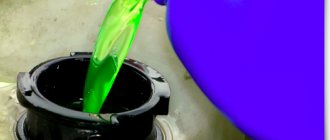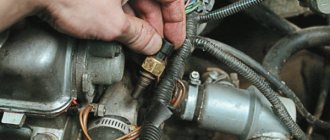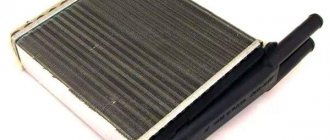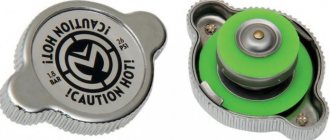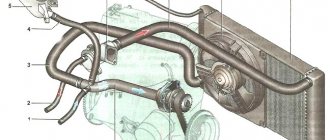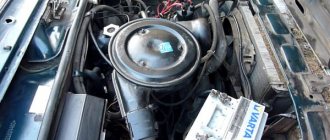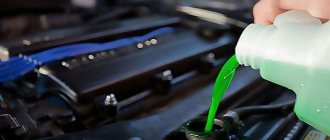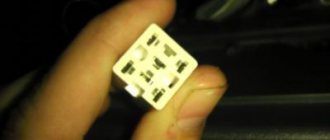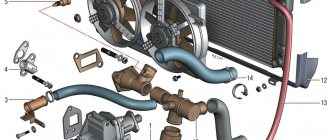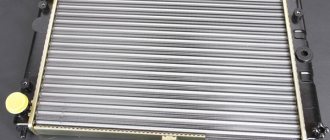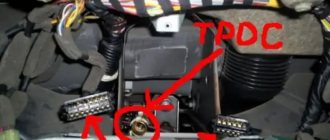When and why to flush
Solving this problem does not require special skills and knowledge, so you can flush the cooling system yourself. It is recommended to do this more often, but even if you perform cleaning once a year, you can achieve a positive effect.
Flushing allows you to avoid the occurrence of various malfunctions associated with the cooling system. The need for this procedure often arises due to the use of low-quality or expired antifreeze, which negatively affects the cooling unit of the car.
You can clean the cooling system less frequently if you adhere to the following rules for using antifreeze:
Simple cleaning products
Almost every owner has distilled water available. It is quite suitable for cleaning the system from simple contaminants. The water washing process is carried out in the following order:
These steps must be repeated until the water is clear when drained. This method will not help get rid of contaminants such as scale or rust.
You can also use lactic acid, caustic soda or vinegar to flush the cooling system. These products need to be mixed with distilled water, and then the same steps described above are performed. There should not be too much acid, otherwise such a solution can damage the rubber and plastic elements of the car. At the end of the procedure, you need to fill in clean distilled water, which is necessary to clean the system of residual solution.
How to wash parts of a VAZ-2110
To flush the VAZ-2110 engine, place a hose into the thermostat outlet, turn on the pressure and monitor the condition of the fluid flowing from the engine.
The heating of the car interior depends on the condition of the stove, so it also needs to be periodically cleaned of dirt:
- open the tap responsible for the heater, remove the hoses from the stove unit;
- using the radiator fitting, attach a hose from which a stream of clean water comes out;
- flushing can be completed only when completely clean water comes out of the second fitting.
To avoid unforeseen and dangerous situations when replacing coolant in a VAZ-2110, the driver must remember the following rules:
- Changing the fluid is permissible only after the engine has completely cooled.
- Cooling solutions must be handled carefully, do not forget about the toxicity of the substances.
And finally, before turning on the car engine, close the filler cap.
Replacing antifreeze and flushing the VAZ 2110 cooling system
What is the best way to flush the cooling system at a service station or do it yourself?
The first option is certainly simpler, but it is also more expensive, the second is less pleasant, but you will gain invaluable experience and also get good savings. If you are not short on time and have a little understanding of what SOD is, then I recommend flushing the cooling system yourself . Read on to find out how to do this.
Features and methods of flushing the cooling system
As I already said, unfortunately, the vast majority of car owners do not even know about the need to carry out such a procedure, perhaps you do the same - just add antifreeze to the level and that’s it. However, this will not always be the case, and at one unpleasant moment the cooling system will simply stop functioning, and you will get overheating with all that it entails. I recommend monitoring the condition of the antifreeze, and not adding it, but making a complete replacement, then during draining you will be able to see what condition it is in. If you have drained the coolant and it is black or dark brown, you know that your cooling system has big problems.
Cooling system design
In order to clean the cooling system, you need to understand what elements it consists of and where the coolant flows.
So, let's look at how the VAZ-2114 engine cooling system works:
Radiator for the cooling system of a carburetor engine VAZ 2108, 2109, 21099
Schematic diagram of the engine cooling system
1 – element in the form of a plug for the expansion tank; 2 – expansion tank; 3 – hose for draining liquid from the pipe; 4 – hose passing between the radiator and the expansion tank; 5 – hose leading from the radiator; 6 – tank to the left of the radiator; 7 – aluminum tube; 8 – plug systems; 9 – tank to the right of the radiator; 10 – drain plug; 11 – middle of the radiator; 12 – casing for electric fan; 13 – plastic wings of the electric fan; 14 – electric motor; 15 – toothed pump pulley; 16 – pump impeller; 17 – camshaft drive belt; 18 – engine block; 19 – pump pipe; 20 – radiator hose with supply function; 21 – heater radiator hose with drain function; 22 – hose supplying coolant to the throttle pipe; 23 – exhaust pipe; 24 – hose for refilling; 25 – heater radiator hose with supply function; 26 – thermostat; 27 – coolant temperature sensor; 28 – coolant level indicator sensor.
When flushing is necessary
Dirt that flows from the cooling system pipe
Everyone understands that the cooling system, especially in the radiator part, can become clogged. This is due to the fact that the operating temperature of the liquid is quite high and it gradually loses its chemical and physical properties.
Thus, it causes residues to settle on the walls of metal tubes, of which there are plenty in this system. But, despite such a difficult diagnosis, it is possible to cope with it.
Of all the available coolants, the heaviest to deposit is antifreeze, although all manufacturers recommend this type. Of course, distilled water is considered the softest for heavy precipitation and leaves almost none, but it has a big disadvantage - it causes corrosion. Read more about choosing a coolant in this material.
Filling liquid to flush the cooling system
It is quite simple to track contamination of the cooling system - the engine gets very hot even in severe frosts.
Another sign is that the thermostat quickly fails (see “replacing the thermostat”). This is due to the fact that the system is overheating. Sometimes, not often, a clogged system can lead to pressure in the system increasing, and the rubber pipes cannot withstand it and begin to leak and crack. In this case, we recommend installing a thermostat from Lada Granta.
Repair, device, signs of malfunction of the VAZ 2110 cooling system
In order to prevent such consequences, it is necessary to clean the cooling system from time to time. As practice shows, and also recommended by car manufacturers, cleaning of pipelines with a complete replacement of the coolant should be done every 50,000 km.
Consequences of a dirty cooling system
In addition to the fact that a clogged system will lead to heating of the engine, as well as the creation of pressure, excessive overheating of the power unit will lead to sagging or deformation of the cylinder head. In this case, the first malfunction that appears is a breakdown of the gaskets. especially under the cylinder head.
The appearance of the coolant seems to hint
Further, a major overhaul of the head may follow, during which it will be necessary to grind the plane, as well as change the main spare parts.
But this is not the whole process of engine destruction due to overheating. If coolant gets into the main power unit, or rather into the cylinders, a water hammer will occur, which will completely disable it.
Methods for cleaning the cooling system
During operation of the cooling system, two most suitable flushing methods were identified:
- External cleaning. This process removes all contaminants from the external cooling elements. This can be done using a spore of water and shampoo. But, with the development of modern technologies, it is best to do this process using a mini-wash, which supplies water liquid with the necessary detergents.
External radiator cleaning with water
There are two types of SOD purification:
External - when insects, dust, oily stains, dirt and other nasty things are removed from the surface of the radiator. Typically, this cleaning is done using a jet and car shampoo.
Dirty radiator - poor cooling
Internal - provides for the removal of deposits consisting of rust, scale, antifreeze decomposition products and rubber parts from the engine cooling jacket and radiator. In addition, contamination and scale are possible in cases where the car owner uses ordinary tap water as coolant. This should not be done under any circumstances, since such water contains a huge amount of salts, impurities and various substances, which, when heated, are deposited on the walls of the cooling system in the form of plaque, complicating heat transfer and reducing the cross-section of the SOD passages.
How often to wash
Before we move on to a direct description of certain products, I would like to remind you how important it is to regularly flush the car’s cooling system. The fact is that, depending on the coolant used, rust, oil deposits, antifreeze decomposition products, and scale accumulate on the walls of the tubes that make up the radiator. All this leads to difficulty in coolant circulation and reduced heat transfer. And this always has a bad effect on the performance of the engine and increases the wear of its individual parts with the risk of their premature failure.
It is worth noting that flushing the system can be both internal and external (external cleaning involves flushing the radiator from the outside to remove particles of dirt, dust, and insects on its surface). It is recommended to do the internal flushing of the cooling system at least once a year . It is best to do this in the spring, when there is no longer frost, and a hot summer lies ahead.
Where does scale and deposits come from in the cooling system?
As you know, antifreeze does not form scale, however, if you do not completely replace it, but constantly add it, then over time its concentration will consist of more than half of water, and the additives that are included in its composition will begin to disintegrate, depositing on the walls thick layer of plaque. Read above about what happens next. Dust, oil, dirt, rubber waste and rust also contribute to contamination and can create a blockage in the cooling system or simply deposit as deposits on the walls.
What to choose?
Many car owners often wonder whether to choose antifreeze or antifreeze: which is better? Let's try to figure out what's what without going into deep truths.
Antifreeze
- In fact, all coolants are and are called antifreeze. And antifreeze is no exception to the rule. In fact, antifreeze is just the name of one of the types of antifreeze developed in our area, for our area and for our cars.
- In terms of its performance and characteristics, antifreeze is in many ways inferior to other antifreezes.
- The price of antifreeze is much lower than other coolants.
- Antifreeze is more common among domestically produced cars.
Antifreeze
- There are very, very many antifreezes in the world. They differ in composition, base, color, and so on.
- Various antifreezes include various special additives that help better maintain the car's cooling system and at the same time increase the service life of the antifreeze itself.
- The cost of antifreeze is higher than antifreeze, and it is quite widespread.
Conclusion
Summarize. Antifreeze or other antifreeze? So:
- Antifreeze is undoubtedly better in quality.
- BUT antifreeze is much more practical for several reasons.
- Antifreeze was SPECIALLY designed for our climate and our cars.
- Antifreeze is available in almost every domestic car that passes you. And this can sometimes save (in case of a breakdown on the road).
- There is enough antifreeze for the car to function normally and the cooling system to work as expected.
It is more practical and cheaper (which is very important) to use antifreeze.
How to rinse SOD?
Flushing the cooling system with water
Although it is possible to flush the system with water, I would strongly advise against it. As I already said, it contains a large amount of impurities and salts that form scale. If there is no other option, then at least use distilled water. Flushing the cooling system using distilled water is done as follows:
Flushing the cooling system with water, acid and vinegar
Water with vinegar and acid is a little better than just water, because thanks to acids you can remove scale and partially clean the cooling system. In order to flush the system using this method, prepare: caustic soda, lactic acid and vinegar. The acid is added carefully and a little at a time; if you overdo it, you can say goodbye to the plastic and rubber parts of the cooling system. To completely remove scale and dirt, it takes 5-10 hours, during which it is necessary to periodically warm up the engine to operating temperature. At the end, all the liquid is drained and distillate is poured in, which is used for the final flushing of the cooling system.
Washing SOD using special chemicals
Specialist. means are the most effective and expensive option. However, the effectiveness of such a procedure is worth the overpayment. Cleaning products contain special cleaning agents that actively remove scale, grease, organic matter, etc.
Flushing specials products are divided into four types: acidic, alkaline, two-component, neutral.
The least popular are acidic and alkaline . Moreover, it is almost impossible to find them undiluted. This is explained by their aggressive effect on the entire cooling system, essentially plastic and rubber products.
Two-component products are very popular and in great demand. Their 2-component solution consisting of alkali and acid copes well with the task. Each of the components is poured into the radiator in turn.
Neutral cooling system cleaning products contain aggressive substances, such as acids or alkalis, and are used exclusively for preventive purposes.
Summing up
As you can see, there are quite a few ways and means to clean the cooling system and each of them has its own characteristics. If you do not want to spend money on expensive cleaning products, follow basic rules that will prevent the formation of plaque and scale. Namely:
That's all for me, thank you all for your attention and for visiting our vaz-remont.ru
Guest_ntc_* 26 Nov 2007
I washed it with a special solution in a jar, added it to the system, ran it for 15 minutes (well, everything was as in the instructions), then drained it and rinsed it 5 times with distilled water, even after 5 times there was a slight sediment in the water, but the water was visually clear.
Torcon Nov 26, 2007
Some other car enthusiasts add water and pour two packs of citric acid, it cleans amazingly. But I was afraid to clean it in such a merciless way: the radiator honeycombs might become clogged with rust and then only replacement.
I just wash it with water, by the way I changed Eneos antifreeze to Valvoline, the car stopped overheating in the summer, it became quite warm in the car. Some strange things.
RadioFanat 29 Nov 2007
2 ntc — write down the brand of flushing. price. where did you get it? everyone is interested
Maxx Nov 29, 2007
Getting rid of air jams
The appearance of air pockets may interfere with normal engine cooling. They sometimes arise in this system. The most basic way to solve this problem is to drive onto an overpass so that the front of the car rises a little. In this case, you do not need to turn off the engine, but just let it run a little. It is even recommended to periodically press on the gas to create different engine speeds. True, this method does not help very often.
If after following these steps the problem still remains, then the following steps should be taken:
- the pipe located on the throttle assembly is removed, which causes the coolant to have the opposite effect;
- add antifreeze directly into the tank until it comes out of this pipe;
- after this, the fitting is plugged and you need to wait for the liquid to flow out of the hose;
- as soon as liquid appears, start the engine and plug the pipe with your finger until antifreeze begins to flow out of the hose on the throttle assembly;
- close the fitting and wait for the coolant to flow out of the hose;
- tighten the pipe and clamp the fastening clamp;
- we start the engine and heat it up to operating condition;
- We turn on the cabin heating system and wait for the hot air flow. If it appears, then the air pockets have been removed.
After completing all the steps, replace the pipe and check the amount of coolant in the expansion tank. If it is not enough, then add it to the required level.
You should not continue driving your car if the internal combustion engine temperature level exceeds a critical value. This may cause the engine to overheat. The reason for the increase in temperature may be the formation of air pockets in the system or simply a missing amount of antifreeze.
It is with this method that you can flush the cooling system yourself in most brands of passenger cars. It should be remembered that distilled water and an anti-scale additive are the best means to clean SOD from unnecessary deposits.
The car engine runs, constantly producing a lot of energy and increasing the temperature. To make it work stably, smart people came up with a liquid cooling system. The coolant in this system needs to be changed periodically. This is what we will do now. These instructions for replacing antifreeze on a VAZ 2109 car will help you change the antifreeze right in your garage with your own hands and without going to a service station or paying for repairs. Photos and videos will tell you how to do it right.
- When is it necessary to replace antifreeze?
- What to choose?
- Antifreeze
- Antifreeze
- Conclusion
- We change antifreeze ourselves
- Tools and fixture
- Draining antifreeze
- Flushing the cooling system
- Pouring antifreeze
- Ending the process
Lada 2109 Bright blue metallic › Logbook › Flushing the cooling system of a VAZ 2109
Hi all. It all started with the fact that my heater radiator was leaking, and after replacing it (I will write about the replacement in the next article), I decided to thoroughly flush the entire cooling system. What was ultimately purchased:
1. Antifreeze Dzerzhinsky A-40M EXTRA 10 kg. 2. Cooling system cleaner MANNOL 9965.
Now I will describe the entire process of my first replacement of antifreeze and flushing the cooling system.
I poured a flushing agent into the old brake fluid, started the car, turned the heater on as high as possible and let it run for about 20-30 minutes. After that, after waiting for the engine to partially cool down, I stocked up with cut-off plastic bottles and a basin for draining, and I also covered the generator so that liquid would not accidentally get on it. I unscrewed the drain plug on the radiator, placed a cut bottle and, by slightly unscrewing the cap of the Antifreeze tank, began to drain the old liquid. I explain that when you start to unscrew the cap on the tank a little, the pressure of the draining Antifreeze becomes stronger, and after the full half of the cut bottle is filled, you screw the cap on the tank back and the pressure becomes barely. When I drained it, I tried to make sure that it flowed out as little as possible, and that’s practically what happened))). After that, I screwed the plug back and began to drain the antifreeze from the engine itself. I also found the fluid drain bolt and unscrewed it with a 13mm wrench and also by unscrewing and tightening the tank cap I drained the antifreeze from there too. Of course, I had to drain it more than once; apparently the cooling system had not been flushed for a very, very long time.
When I cleaned the system with manol, the drained liquid was of this color:
After that, I started filling the cooling system with water and starting the car in the same way, warming it up, then draining and draining until I had more or less clear water in my basin.
The first flush with water, after cleaning the cooling system with manol. I took the photo in the evening, so in some photos the water may seem either dirtier or clearer
When I drained it the last time, the water turned out to be more or less transparent, this is the result I was trying to achieve
In the second and third photos, I drained the antifreeze only from the radiator, because... on the engine, I could not unscrew the drain bolt, and in the 3rd photo and subsequent ones I drained the antifreeze completely. After each fill of a new batch of water, I pressed on 2 hoses, on the hose that comes from the thermostat and on the hose that goes from the engine to the radiator, and I did this in order to expel air from the system.
After the entire procedure, the heater began to heat better, the car stopped overheating in the summer heat, otherwise previously it was necessary to turn on the cooling fan and the heater at 1st speed to avoid overheating.
In total, I had to rinse 9 times to get almost clean water. Even though I did this whole procedure and replaced the radiator with a new one, the side nozzles still blow barely warm air. Who can say anything about this? All peace and goodness.)))
Like 21 Subscribe
TOP 3 best liquids for flushing the cooling system
LAVR Radiator Flush LN1106
LAVR Radiator Flush Classic . LAVR is a Russian brand of auto chemical goods. LAVR Radiator Flush Classic is an excellent solution for flushing the cooling system of any car. Product catalog number is LN1103. The approximate cost of a 0.43 liter package is $3.5, and a 0.98 liter package is $5.10.
A 430 ml bottle will be enough for you to use in a cooling system with a total volume of 8.10 liters. The composition is poured into the system and topped up with warm water to the MIN mark. After this, the engine should run for about 30 minutes at idle speed. Next, the product is removed from the system and washed with distilled water for 10.15 minutes with the engine running at idle. After this, you can fill in new antifreeze.
The useful properties of the product include an increase in the service life of antifreeze by 30.40%, effective removal of scale, antifreeze decomposition products, rust, and dirt. Contains a corrosion inhibitor, increases the life of the pump and thermostat.
| Positive feedback | Negative reviews |
| I simply used the Laurel wash because literally shortly before I had just used a ring decarbonizer under the same name, I saw the result, so I decided not to tempt fate and use a product from the same company. | No negative reviews found. |
| At one time I also used Laurel on a VAZ-21099. The impressions are only positive. But I also did washings every two years. So I never had dirt in the cooling system. | . |
7-Minute Hi-Gear Radiator Flush
Hi-Gear Radiator Flush - 7 minutes . Manufactured in the USA by Hi-Gear. Sold in the CIS countries, as well as Europe and America. Hi-Gear cooling system flushing is a very popular remedy among motorists all over the world. Article: HG9014. The price of one 325 ml can is about $4.6.
A 325 ml can will be enough for you to flush a cooling system with a volume of up to 17 liters. The product can be used to clean cooling systems of cars and trucks. A distinctive feature is the short operating time, namely 7 minutes .
The useful properties of the product include the fact that it increases the efficiency of the radiator by 50.70%, eliminates overheating of the cylinder walls, restores coolant circulation, reduces the likelihood of engine overheating, and protects the pump seal. The product does not contain acids, does not require neutralization, and is not aggressive to plastic and rubber parts.
| Positive feedback | Negative reviews |
| I have been using Hi-Gear (USA) flushing products from this company since I purchased my first car, I have never had any complaints, especially with “injector cleaners” | I liked the Hadov washing system better + it’s cheaper. |
| After a cheap wash it didn’t get better, but high gear helped | . |
LIQUI MOLY Kuhler-Reiniger
LIQUI MOLY Kuhler-Reiniger . This is a popular product from a well-known German manufacturer of auto chemicals. It can be used in any cooling and heating systems. Does not contain aggressive alkalis and acids. The approximate price of a 300 ml can is $6.8. Article - 1994.
Perfect for car owners who want to flush the engine cooling system of oil, emulsion and rust. A 300 ml jar is enough to create 10 liters of cleaning liquid. The product is added to the coolant and the engine is left running for 10.30 minutes. After this, the system is cleaned and new antifreeze is added.
The cleaner dissolves fat, oil and lime deposits, removes dirt and sediment. The substance is neutral to plastics, rubber, compatible with any coolants. Does not contain aggressive acids and alkalis.
| Positive feedback | Negative reviews |
| To be honest, I was surprised by the result, the oil in the pipes was washed away, I ran my finger inside the pipe, not even a hint of oil remained. | I washed it with licumol and it didn’t do anything, but the foam is still standing in the tank. The info said that it even removes rust, and yes, it was exactly the opposite. |
| After replacing the heater radiator, I filled it with dis/water, it washed out well, why I say it’s good, because my old antifreeze was basically clean, it was just time to change it, and after washing a little scale came out, then I poured in new antifreeze, so now it’s like a tear, only bluish. | Tried Liqui Molly on an old car - in my opinion it's garbage |
This is not a complete list of products for cleaning the cooling system of cars, which are sold in stores in our country. However, we focused only on the more popular ones, since they have proven themselves better than others. Any of the listed products can be used to flush the system, for example, when oil gets into the antifreeze.
conclusions
As you can see, the choice of OS cleaning products is quite wide. We recommend that you use professional products , and not various folk methods that are used to flush the engine cooling system at home, when it is not possible to buy special products. This way you will protect the cooling and other systems of your car from possible breakdowns and extend their service life. Since various acids corrode not only the sediment, but some components and parts of the OS.
Also remember that if you want to switch from one brand of antifreeze to another, you must always flush the cooling system with clean distilled water. This is the simplest and cheapest method of preventive cleaning of the OS.
Source
